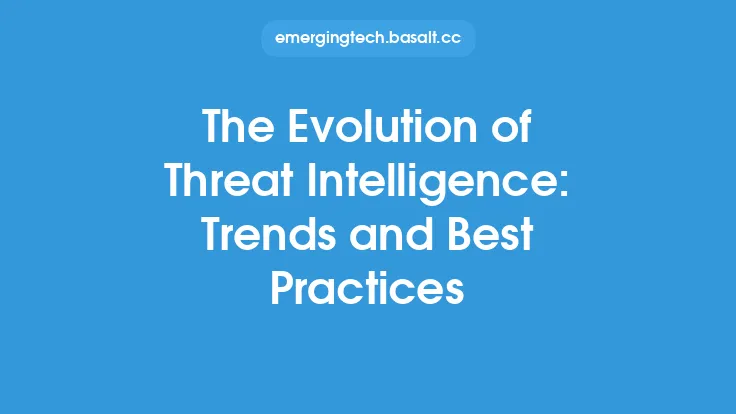The field of incident response has undergone significant transformations over the years, driven by the evolving threat landscape, advancements in technology, and the increasing importance of cybersecurity in modern organizations. As the frequency and sophistication of cyberattacks continue to rise, incident response has become a critical component of any organization's cybersecurity strategy. In this article, we will delve into the evolution of incident response, exploring the trends and predictions that are shaping the future of this field.
Introduction to Incident Response
Incident response refers to the process of responding to and managing the aftermath of a cybersecurity incident, such as a data breach, malware outbreak, or denial-of-service (DoS) attack. The primary goal of incident response is to minimize the impact of the incident, contain the damage, and restore normal business operations as quickly as possible. Effective incident response requires a combination of technical expertise, communication skills, and strategic planning. Over the years, incident response has evolved from a reactive, ad-hoc approach to a proactive, structured methodology that emphasizes preparation, detection, and response.
Historical Context of Incident Response
In the early days of cybersecurity, incident response was largely focused on responding to viruses and other types of malware. As the internet and network connectivity became more widespread, the threat landscape expanded to include hacking, phishing, and other types of cyberattacks. In response, incident response teams began to develop more formalized processes and procedures for managing incidents. The introduction of incident response frameworks, such as the National Institute of Standards and Technology (NIST) Cybersecurity Framework, provided a structured approach to incident response and helped to establish common terminology and best practices.
Current Trends in Incident Response
Today, incident response is a complex and multifaceted field that involves a range of technical, operational, and strategic considerations. Some of the current trends in incident response include:
- Increased use of automation and orchestration: Automation and orchestration tools are being used to streamline incident response processes, reduce manual errors, and improve response times.
- Greater emphasis on threat intelligence: Threat intelligence is playing a critical role in incident response, enabling organizations to anticipate and prepare for potential threats.
- Growing importance of cloud security: As more organizations move to the cloud, incident response teams must be equipped to respond to cloud-based incidents, such as data breaches and cloud-based malware attacks.
- Rise of incident response as a service: Incident response as a service (IRaaS) is becoming increasingly popular, providing organizations with access to expert incident response capabilities on a pay-as-you-go basis.
Predictions for the Future of Incident Response
As the threat landscape continues to evolve, incident response will need to adapt to new challenges and opportunities. Some predictions for the future of incident response include:
- Increased use of artificial intelligence and machine learning: Artificial intelligence (AI) and machine learning (ML) will play a greater role in incident response, enabling organizations to detect and respond to threats more quickly and effectively.
- Greater emphasis on proactive incident response: Proactive incident response will become more prevalent, with organizations focusing on preventing incidents from occurring in the first place, rather than simply responding to them after the fact.
- Growing importance of cybersecurity awareness and training: Cybersecurity awareness and training will become increasingly important, as organizations recognize the critical role that employees play in preventing and responding to incidents.
- More focus on incident response metrics and measurement: Incident response metrics and measurement will become more important, enabling organizations to evaluate the effectiveness of their incident response efforts and identify areas for improvement.
Technical Advances in Incident Response
From a technical perspective, incident response is being shaped by a range of advances, including:
- Improved threat detection and analytics: Advanced threat detection and analytics tools are enabling organizations to detect and respond to threats more quickly and effectively.
- Enhanced incident response platforms: Incident response platforms are becoming more sophisticated, providing organizations with a centralized platform for managing incident response activities.
- Greater use of security information and event management (SIEM) systems: SIEM systems are being used to collect, monitor, and analyze security-related data, enabling organizations to detect and respond to incidents more quickly.
- Increased adoption of cloud-based incident response tools: Cloud-based incident response tools are becoming more popular, providing organizations with greater flexibility and scalability in their incident response efforts.
Challenges and Opportunities in Incident Response
Despite the advances being made in incident response, there are still a number of challenges and opportunities that organizations must address. Some of the key challenges include:
- Limited resources and budget: Many organizations struggle to allocate sufficient resources and budget to incident response, making it difficult to respond effectively to incidents.
- Lack of skilled personnel: The shortage of skilled cybersecurity personnel is a major challenge for many organizations, making it difficult to build and maintain effective incident response teams.
- Evolving threat landscape: The threat landscape is constantly evolving, with new threats and vulnerabilities emerging all the time. Organizations must be able to adapt quickly to these changes in order to respond effectively.
- Regulatory compliance: Incident response is subject to a range of regulatory requirements, including data breach notification laws and incident response standards. Organizations must be able to demonstrate compliance with these regulations in order to avoid fines and reputational damage.
In conclusion, incident response is a critical component of any organization's cybersecurity strategy, and its evolution is being shaped by a range of technical, operational, and strategic considerations. As the threat landscape continues to evolve, incident response will need to adapt to new challenges and opportunities, leveraging advances in technology, process, and people to respond more quickly and effectively to incidents. By understanding the trends and predictions that are shaping the future of incident response, organizations can better prepare themselves to respond to the cybersecurity challenges of tomorrow.





